 Credit: Nvidia
Credit: Nvidia
After months of speculation and leaks, Nvidia’s long-awaited GeForce RTX 2070 Super and 2080 Super GPUs are coming to laptops, launching Thursday in unison with Intel’s “Comet Lake-H” 10th-gen Core processors for mobile gaming.
That’s great! But believe it or not, it may be Nvidia’s least enticing announcement today. The company also announced cheaper prices for gaming laptops across the board, and some massive upgrades to its energy-efficient Max-Q technology to let GeForce GPUs soar even higher when they’re paired with Intel and AMD’s latest notebook processors.
Let’s look at the new GPUs and Nvidia’s pricing changes first, then dive into the Max-Q tweaks, since they’re worth deeper explanation.
The Super-fied laptop incarnations revolve around the same underlying hardware as desktop GeForce RTX 2070 Super and RTX 2080 Super, but tuned for lower clocks and power draw, per usual for Nvidia’s modern laptop lineup. That should make the GeForce RTX 2070 Super ideal for laptops with 1440p or high refresh-rate 1080p displays, and the RTX 2080 Super great for 4K or ultra-fast 1440p gaming. And yes, they’re capable of real-time ray tracing in games that support the cutting-edge tech.
Pricing-wise, Nvidia says that laptops with the new GPUs will cost the same as the non-Super versions of these graphics did originally. We’d expect GeForce RTX 2070 Super laptops to cost $1,500 and up, and gaming notebooks with a GeForce RTX 2080 Super inside to go for north of $2,000.
The rest of the mobile GeForce laptop is getting cheaper, though.
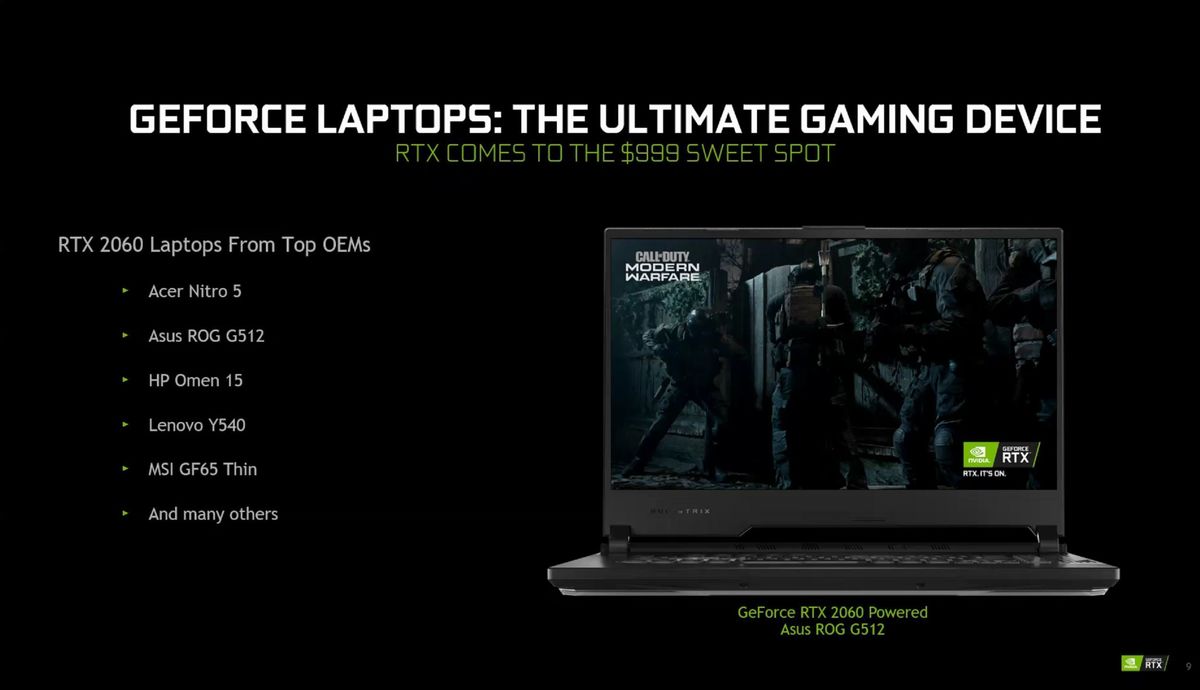 Nvidia
NvidiaStarting at the bottom, Nvidia says we’ll start to see laptops with the entry-level GeForce GTX 1650 starting at $699. (As a “GTX” GPU rather than an “RTX” GPU, this chip lacks real-time ray tracing.) We’ve seen GTX 1650 laptops selling for this price before—even laptops with a more potent GTX 1660 Ti inside—but only on sale.
Moving another rung up the ladder, Nvidia didn’t mention expected GTX 1660 Ti laptop pricing. It must be getting cheaper, though, because notebooks with the vaunted GeForce RTX 2060 inside will start at $999, bringing real-time ray tracing to the pricing “sweet spot” for mobile gaming. Before, you could expect to spend $1,200 or more on an RTX 2060 laptop unless you found a particularly juicy deal. Virtually all the top notebook makers already offer RTX 2060-equipped laptops, and Nvidia expects the GPU to become even more popular at this lower price point.
Finally, the non-Super GeForce RTX 2070 will be sticking around, but in much cheaper notebooks. Nvidia says this GPU will now appear in laptops starting at $1,199 to $1,299—what those less-potent RTX 2060 laptops cost until today.
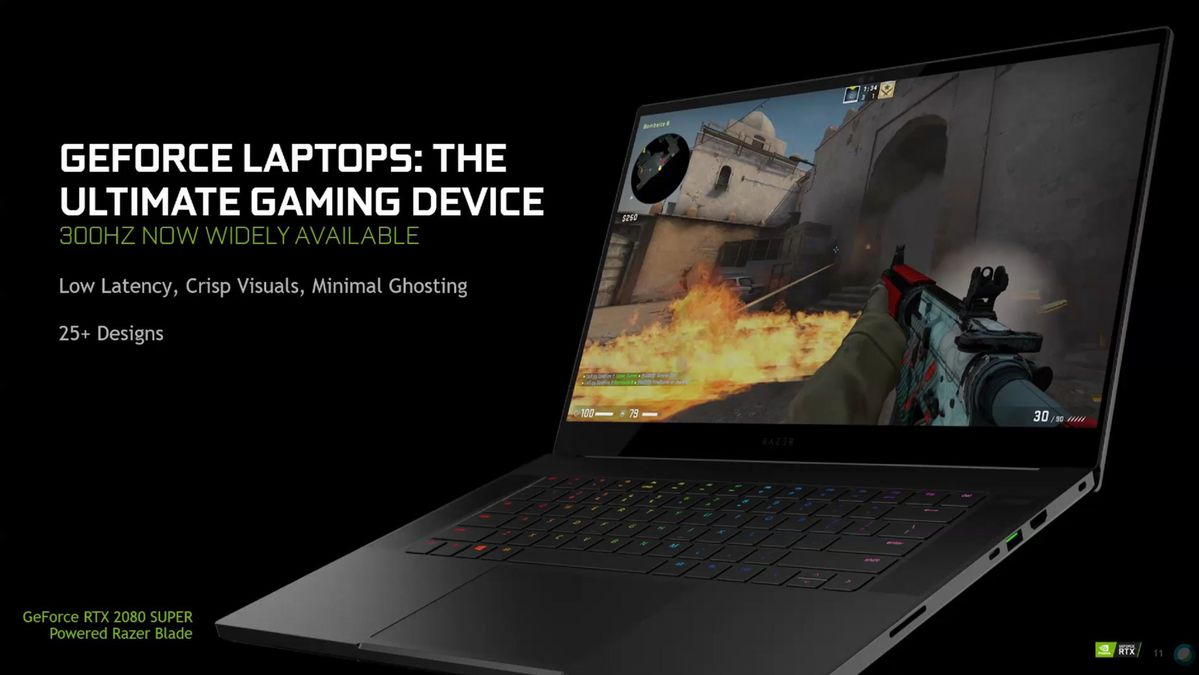 Nvidia
NvidiaAll told, this will be the biggest mobile GeForce launch ever for Nvidia, with more than 100 laptop designs expected, coming from every single laptop maker. (That number’s a bit wiggly, however, as we’ll likely see 100+ laptops with GeForce paired with Intel and AMD’s new notebook CPUs, while only the RTX Super chips are truly new from Nvidia.) Better yet, Nvidia says that every single RTX laptop will support 144Hz display options, and over 25 notebooks with blisteringly fast 300Hz screens are on the way.
Nvidia Max-Q gets even more power-efficient
But wait, there’s more! These 100+ new laptop designs should be even more efficient than previous GeForce-packing laptops—even previous RTX laptops—thanks to improvements made to Nvidia’s Max-Q technology.
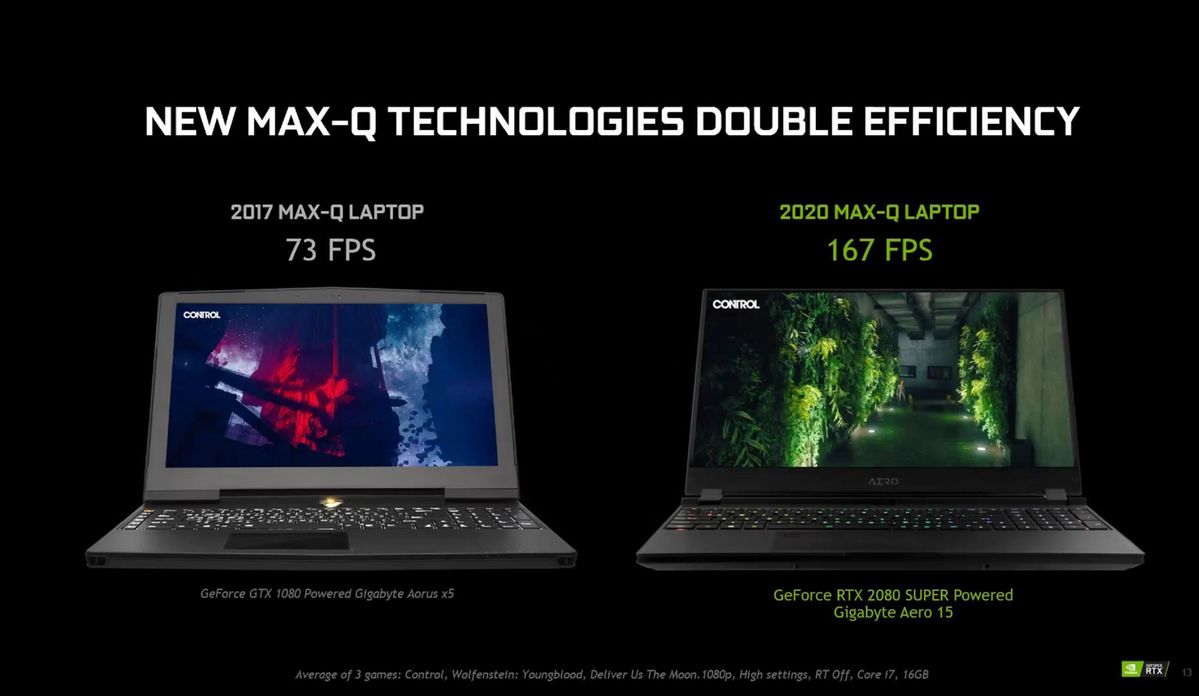 Nvidia
NvidiaNvidia introduced Max-Q several years ago with the mobile GeForce GTX 10-series lineup. Max-Q technology was pivotal in finally making gaming laptops at least somewhat portable to outright svelte (case in point: the new Asus ROG Zephyrus G14). Max-Q GPUs ship with lowered clock speeds and power draws than their full-fat, non-Max-Q laptop cousins, and include other tweaks to improve power efficiency.
As of Thursday, Nvidia’s rolling out fresh enhancements that will be included in GeForce notebooks going forward. The company claims that with these improvements in place, new Max-Q laptops are twice as efficient as comparable last-gen models from 2017. That’s a bit of a wishy-washy number because it includes efficiencies introduced by DLSS 2.0, a game-specific Nvidia technology that developers need to implement manually. Nvidia claims DLSS 2.0 can boost battery life by up to 20 percent during gaming, but it’s in only four games at this time. Even so, DLSS 2.0 is exciting stuff, and the other Max-Q upgrades are also well worth getting excited about.
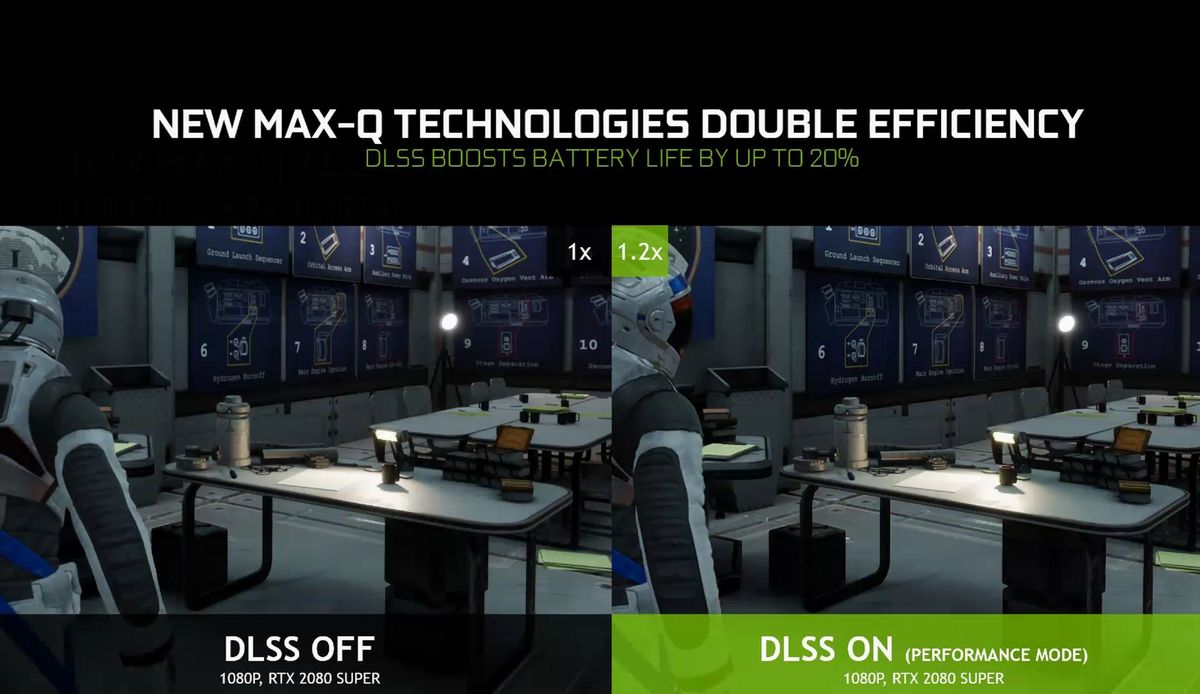 Nvidia
NvidiaLet’s start at the lowest level before digging into the really juicy stuff. These new Max-Q GPUs include lower-voltage GDDR6 memory as well as “next-gen” voltage regulators to improve overall efficiency. Mark Aevermann, Nvidia’s laptop product manager, said that of the 80 watts of power allowed for typical Max-Q designs, 25 percent of that is dedicated to driving the memory. Meanwhile, another 15 percent of those 80W are pure voltage loss to heat. Fortifying these subsystems lets Nvidia drive more power to the GPU itself, which in turn means more performance in your games.
Dynamic Boost
The new Dynamic Boost feature is what really gives your GPU more juice when needed most. Dynamic Boost sounds a lot like AMD’s SmartShift technology, which debuted in Ryzen 4000 laptops. No matter what you call it, it sounds wonderful.
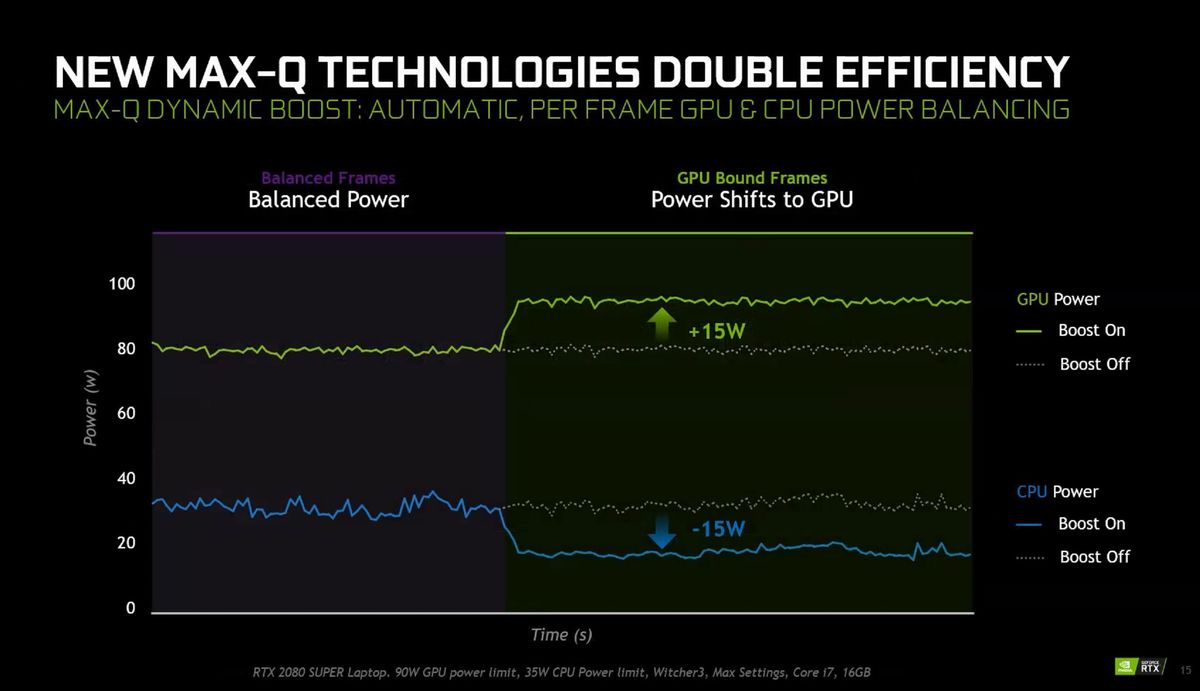 Nvidia
NvidiaEssentially, when the GPU is performing a task that requires more horsepower, the laptop shifts power from the CPU, and vice-versa when the CPU needs some extra oomph. Yes please! Aevermann says Dynamic Boost can give you up to 10 percent more performance in games, though that’s the high-water mark. Its effect varies greatly depending on what’s actually going on in the specific scene of the specific game you’re playing. And yes, we mean “game” specifically, as Dynamic Boost currently hooks into DirectX and Vulkan. Nvidia didn’t rule out the idea of expanding it to function with other types of software in the future.
The new feature functions on a variety of levels to make its power adjustments, including the hardware level. Unfortunately, that means Dynamic Boost won’t be coming to prior versions of GeForce laptops. The technology requires deeper communication with the CPU to function, and that’s possible only with the “Comet Lake-H” 10th-gen Core processors Intel announced at the same time as Nvidia’s announcements, as well as laptops with AMD’s Ryzen 4000 CPUs, which launched earlier this week. (It could theoretically work with lower-power U-class laptops, Aevermann said, but the results would be limited because those CPUs generally have only 15W going to the processor.)
 Nvidia
Nvidia
Dynamic Boost's effect on frame rate in RTX 2080 Super-powered Acer Predator Triton 500.
Systems will also need to be configured to pass more power to the GPU and CPU than the hard limits common in the pre-Dynamic Boost era. You can’t just toss 15 percent more power at a sensitive silicon chip without planning for it.
On the plus side, Nvidia expects Dynamic Boost to be supported in the vast majority of newly designed Max-Q systems—not just ones with the RTX 2070 Super or 2080 Super inside. Dynamic Boost works with the entire GeForce mobile lineup going forward, including the GTX 1650.
Advanced Optimus
Here's another new feature: Max-Q now supports Advanced Optimus, an upgrade that allows laptops to incorporate G-Sync panels with less impact to battery life. Say it with me: Hallelujah.
Nvidia’s G-Sync technology makes games buttery-smooth while eliminating ugly stuttering and screen-tearing, by synchronizing the output of your GeForce GPU with the refresh rate of your monitor. It’s wonderful—but it needs Nvidia’s hardware to be active, and powered-on discrete graphics draw vastly more energy than the integrated graphics in your laptop’s CPU.
In laptops, Nvidia’s Optimus technology routes the Nvidia GPU’s visuals through the CPU’s integrated graphics to save power. Because they're mutually exclusive technologies, gaming laptops with G-Sync displays have offered significantly less battery life than gaming laptops with a standard display and Optimus. That might be why we’ve been seeing more and more notebooks with high-refresh-rate screens but no G-Sync.
Advanced Optimus changes all that.
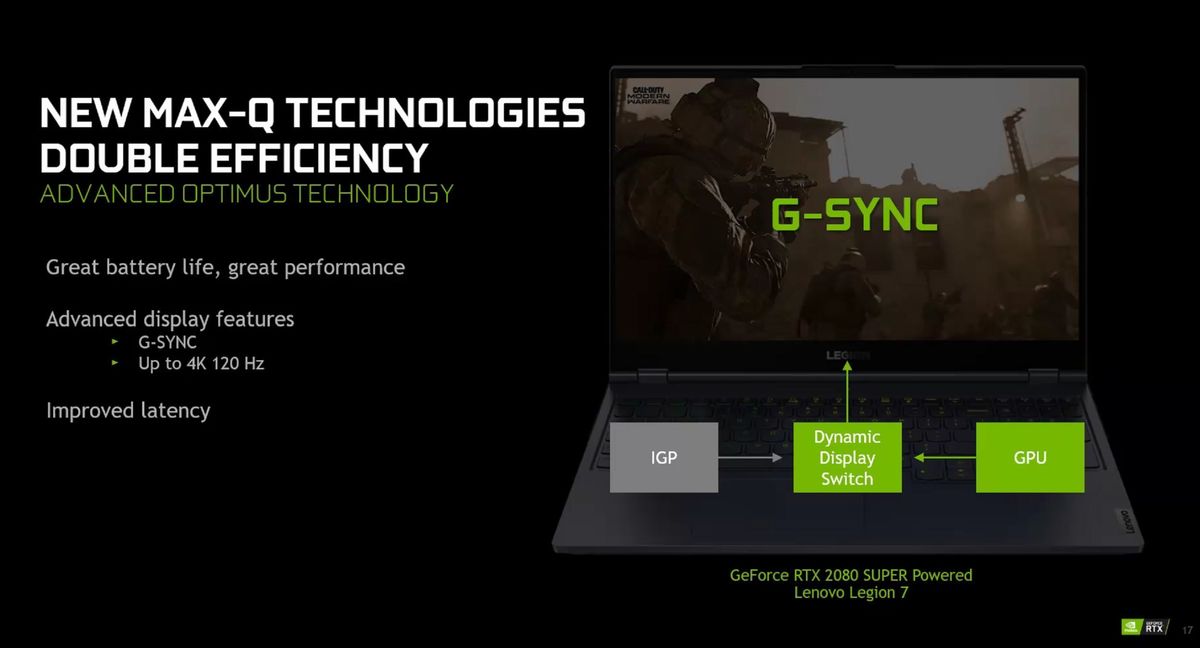 Nvidia
NvidiaThis new technology connects both Nvidia’s GeForce GPU and your laptop processor’s integrated CPU to a dynamic display switch. When you’re gaming or performing other GPU-intensive tasks, the switch hands display output directly over to Nvidia’s graphics chip, enabling higher frame rates and yes, full G-Sync support. When you’re not, however, the dynamic switch hands full control over to your system’s integrated graphics to save power. Advanced Optimus no longer keeps the GeForce GPU active when you aren’t gaming, letting you have your cake and eat it too—or have G-Sync and lower power usage when you aren’t gaming, in other words. Again: Hallelujah.
Note that Advanced Optimus isn’t mandated for the new breed of GeForce Max-Q GPUs; it’s an optional feature that laptop makers may choose to implement. Nvidia says the Lenovo Legion 5i and 7i will be the first to include Advanced Optimus, though “many others” are coming.
RTX Studio laptops
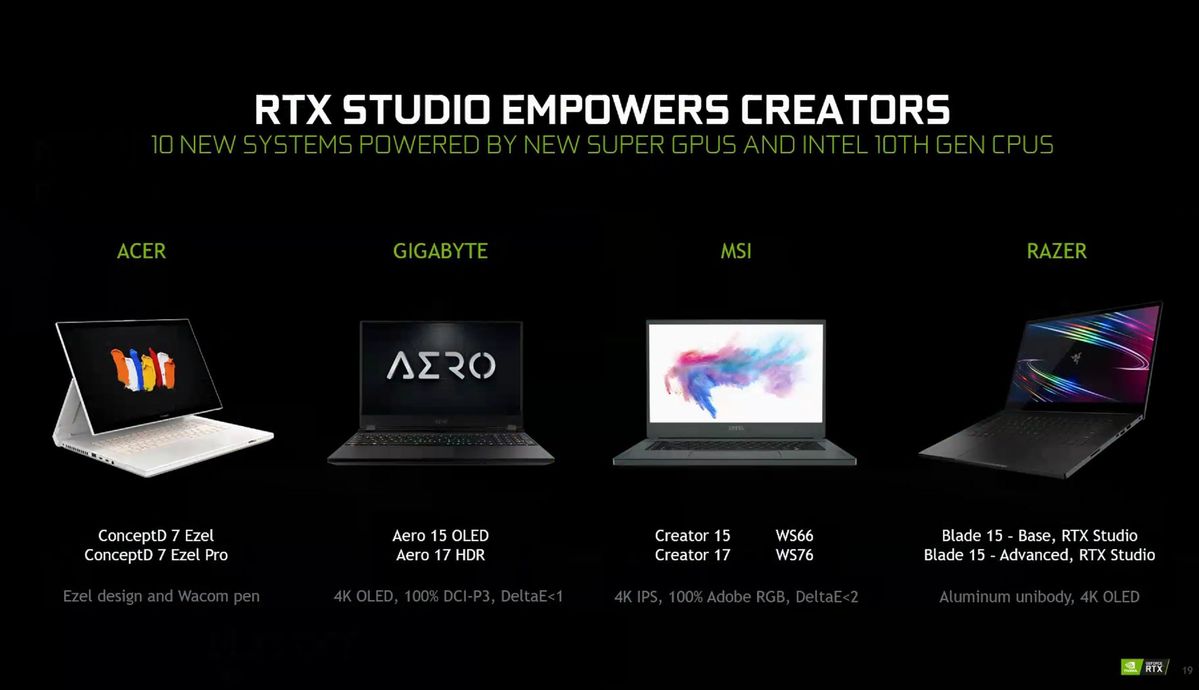 Nvidia
NvidiaFinally, Nvidia announced 10 new RTX Studio laptops are coming, with RTX Super GPUs and Intel’s 10th-gen Core processors inside. Nvidia’s RTX Studio initiative certifies that a notebook gives content creators powerful computer hardware and rock-solid, creation-focused “Nvidia Studio” drivers to match, all in a slimmer-than-you’d-think design enabled by Max-Q.
RTX Studio laptops need the following at a minimum:
- GPU: RTX 2060, Quadro RTX 3000 or higher
- CPU: Intel Core i7 (H-series) or higher
- RAM: 16GB or higher
- SSD: 512GB or higher
- Display: 1080p or 4K
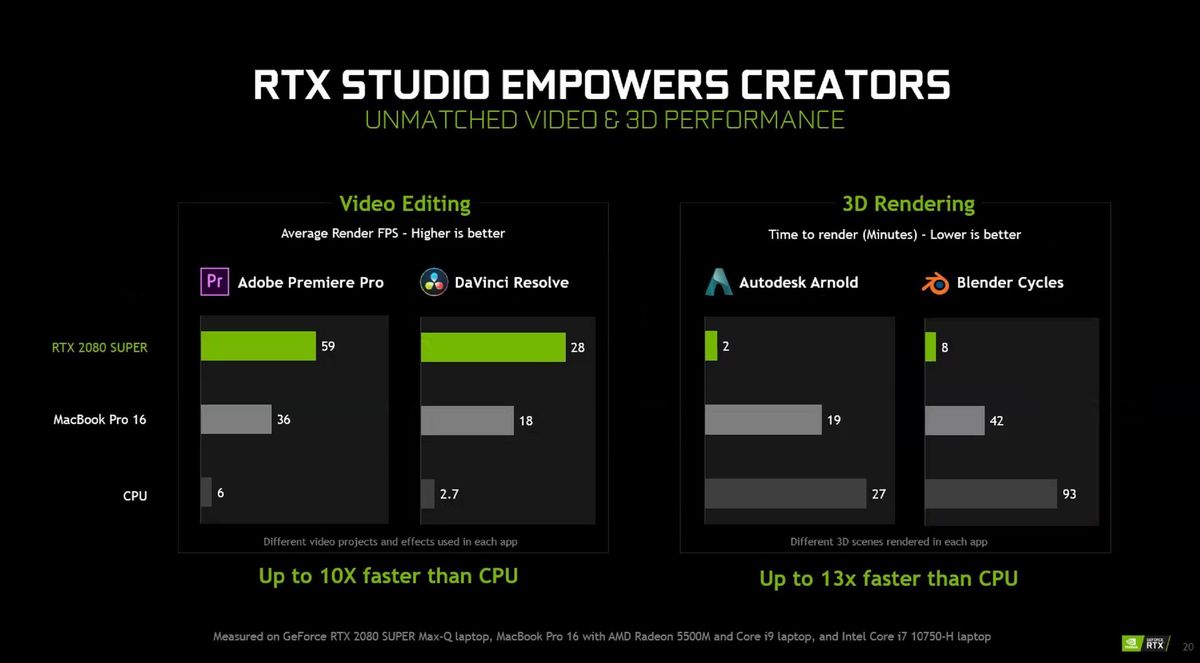 Nvidia
NvidiaNvidia says this new class of RTX Studio laptops is much, much faster than the AMD Radeon 5500M-equipped Apple Mac Pro at common tasks like Adobe Premiere Pro video editing and Blender 3D rendering, and obnoxiously faster than trying to perform the same tasks on one of Intel’s new Core i7-10750H processors by its lonesome. Over 45 different creative apps are now “RTX accelerated” as part of the company’s Studio endeavor, including most of the big-name software you’d expect to see.

















